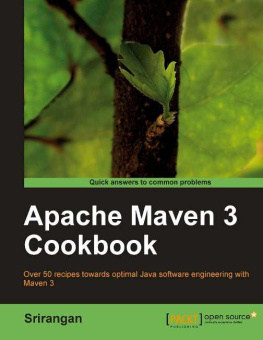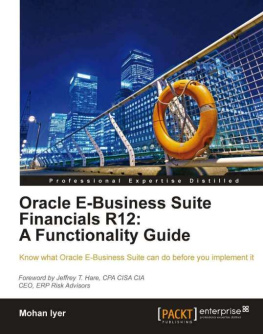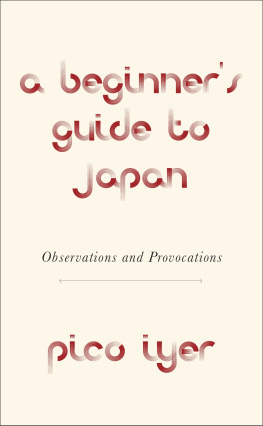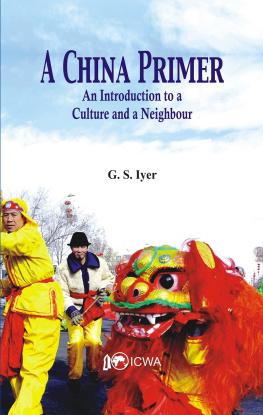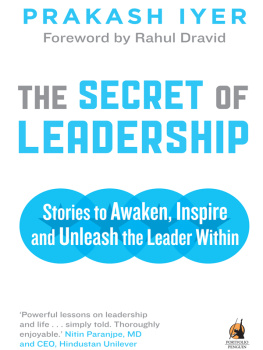Iyer - Video Night in Kathmandu
Here you can read online Iyer - Video Night in Kathmandu full text of the book (entire story) in english for free. Download pdf and epub, get meaning, cover and reviews about this ebook. year: 2010;2001, publisher: Knopf Doubleday Publishing Group, genre: Detective and thriller. Description of the work, (preface) as well as reviews are available. Best literature library LitArk.com created for fans of good reading and offers a wide selection of genres:
Romance novel
Science fiction
Adventure
Detective
Science
History
Home and family
Prose
Art
Politics
Computer
Non-fiction
Religion
Business
Children
Humor
Choose a favorite category and find really read worthwhile books. Enjoy immersion in the world of imagination, feel the emotions of the characters or learn something new for yourself, make an fascinating discovery.

- Book:Video Night in Kathmandu
- Author:
- Publisher:Knopf Doubleday Publishing Group
- Genre:
- Year:2010;2001
- Rating:4 / 5
- Favourites:Add to favourites
- Your mark:
- 80
- 1
- 2
- 3
- 4
- 5
Video Night in Kathmandu: summary, description and annotation
We offer to read an annotation, description, summary or preface (depends on what the author of the book "Video Night in Kathmandu" wrote himself). If you haven't found the necessary information about the book — write in the comments, we will try to find it.
Mohawk hair-cuts in Bali, yuppies in Hong Kong and Rambo rip-offs in the movie houses of Bombay are just a few of the jarring images that Iyer brings back from the Far East.
From the Trade Paperback edition.
Video Night in Kathmandu — read online for free the complete book (whole text) full work
Below is the text of the book, divided by pages. System saving the place of the last page read, allows you to conveniently read the book "Video Night in Kathmandu" online for free, without having to search again every time where you left off. Put a bookmark, and you can go to the page where you finished reading at any time.
Font size:
Interval:
Bookmark:

P ICO I YER S
VIDEO NIGHT IN KATHMANDU
Delightful Pico Iyers remarkable talent is enough justification for going anywhere in the world he fancies.
Washington Post Book World
A surprising and clever book. Like the lost traveler stumbling on Shangri-La, Iyer has hit on the hidden beauty of traveling in the late twentieth century.
The Nation
Some of the most polished travel writing to appear in a long time - always revealing, sometimes reflective, frequently riotious. Iyer displays a sharpshooters eye for evocative detail. Fresh and immensely accomplished.
Kirkus Reviews
The best writers of travel seem to invent the places they bring to life. This is why I am certain that Pico Iyer invented modern Asia. No other explanation could account for his producing so shrewd, so funny, so dazzling a book.
Roger Rosenblatt
An offbeat, brilliant book funny and alarming.
Boston Herald
Enough anomaly to fill a shelf of travel books. Iyer is especially sensitive to cross-cultural confusion. His books mix of thoughtful essay and personal reportage describes a relationship whose ambiguity stands as its principal characteristic. Iyers trip [may be] a journey into our own future.
Philadelphia Inquirer
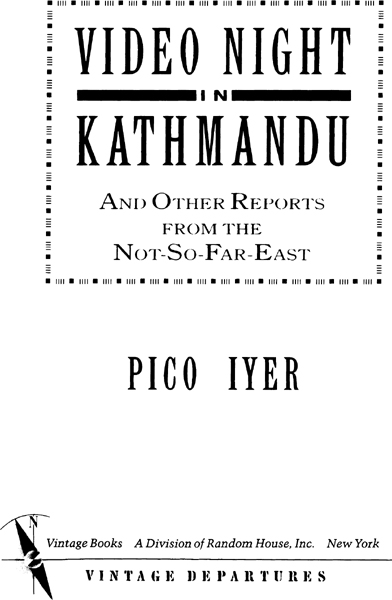
BALI:
On Prosperos Isle
TIBET:
The Underground Overland Invasion
NEPAL:
The Quest Becomes a Trek
CHINA:
The Door Swings Both Ways
THE PHILIPPINES:
Born in the U.S.A.
BURMA:
The Raj is Dead! Long Live the Raj!
HONG KONG:
The Empires New Clothes
INDIA:
Hollywood in the Fifties
THAILAND:
Love in a Duty-free Zone
JAPAN:
Perfect Strangers
To my mother and father,
Guides, guardians and friends
Wind in the west,
fallen leaves
gathering in the east.
Buson
All tourist people are my bread and butter. So I need to help everything as I could. If I do not help them, they will never forgive me because I fully understand their love or sincerity. I dont have enough money, but I need to pay their gratitude at one day.
The credo of Maung-Maung,
trishaw driver,
chalked up on a blackboard inside
his hut in Mandalay
R AMBO HAD conquered Asia. In China, a million people raced to see First Blood within ten days of its Beijing opening, and black marketeers were hawking tickets at seven times the official price. In India, five separate remakes of the American hit went instantly into production, one of them recasting the macho superman as a sari-clad woman. In Thailand, fifteen-foot cutouts of the avenging demon towered over the lobbies of some of the ten Bangkok cinemas in which the movie was playing, training their machine guns on all who passed. And in Indonesia, the Rambo Amusement Arcade was going great guns, while vendors along the streets offered posters of no one but the nations three leading deities: President Suharto, Siva and Stallone.
As I crisscrossed Asia in the fall of 1985, every cinema that I visited for ten straight weeks featured a Stallone extravaganza. In Chengdu, I heard John Rambo mumble his First Blood truisms in sullen, machine-gun Mandarin and saw the audience break into tut-tuts of headshaking admiration as our hero kerpowed seven cops in a single scene. In Jogjakarta, I went to Rambo on the same night as the Ramayana (though the modern divinity was watched by hosts of young couples, stately ladies in sarongs and bright-eyed little scamps, many of whom had paid the equivalent of two months salary for their seats, while, on the other side of town, the replaying of the ancient myth remained virtually unvisited). Just five days later, I took an overnight bus across Java, and, soon enough, the video screen next to the driver crackled into life and therewho else?was the Italian Stallion, reasserting his Dionysian beliefs against Apollo Creed. As the final credits began to roll, my neighbor, a soldier just returned from putting down rebels in the jungles of East Timor, sat back with a satisfied sigh. That, he pronounced aptly, was very fantastic.
Silencing soldiers, toppling systems, conquering millions and making money fist over fist across the continent, Rambo was unrivaled as the most powerful force in Asia that autumn. No man, no law, no woman can stop him, gasped the ads in the Bangkok papers. Everyone Is Applauding Screens Most Invincible Hero, agreed one of the three ads on a single page of Indias respected Statesman. The Second Greatest U.S. Box Office Hit in History, roared the marquee in faraway Sabah. I think hes very beautiful, cooed a twenty-three-year-old Chinese girl to a foreign reporter. So vigorous and so graceful. Is he married?
Rambo had also, I knew, shattered box-office records everywhere from Beirut to San Salvador. But there seemed a particular justice in his capturing of Asian hearts and minds. For Rambos great mission, after all, was to reverse the course of history and, single-fisted, to redress Americas military losses in the theaters of Asia. And in a way, of course, the movies revisionism had done exactly that, succeeding where the American army had failed, and winning over an entire continent. Some of the appeal of the blockhead-buster lay, no doubt, in its presentation of a kung fu spectacular more professional than the local efforts and more polished than the competing displays of Norris and Bronson. Some might just have reflected the after-tremors of its earthshaking reception in the States. But whatever the cause of the dramas success, the effect was undeniable: millions of Asians were taking as their role model an All-American mercenary. When William Broyles returned to his old battlegrounds in Vietnam in 1984, he found the locals jiving along to Born in the U.S.A., Bruce Springsteens anthem for the disenfranchised Vietnam vet, and greeting him with cries of America Number One! America, concluded Broyles, is going to be much more difficult to defeat in this battle than we were in the others. Our clothes, our language, our movies and our musicour way of lifeare far more powerful than our bombs.
The prospect of witnessing that low-intensity conflict was one of the impulses that took me first to Asia. Over the course of two years, I spent a total of seven months crisscrossing the continent on four separate trips, mostly in order to see its sights, but also in order to visit the front lines of this cultural campaign. I was interested to find out how Americas pop-cultural imperialism spread through the worlds most ancient civilizations. I wanted to see what kind of resistance had been put up against the Coca-Colonizing forces and what kind of counter-strategies were planned. And I hoped to discover which Americas got through to the other side of the world, and which got lost in translation.
This contest for cultural sovereignty was nothing new, of course. Colonel Sanders and General Motors had first set up base camps across the global village years ago, and Americas Ambassador-at-Large throughout the world had long been the retired World War I flying ace Snoopy. Fifteen years before the first American troops showed up, Norman Lewis described families in Saigon listening respectfully to a local rendition of When Irish Eyes Are Smiling. And fully a quarter century ago, Arthur Koestler had stated as a given that the world was moving toward a uniform, mechanized, stereotyped culture, a mass culture that struck him as a form of mass suicide. The syllogism was old enough now to be almost an axiom: pop culture ruled the world, and America ruled pop culture. Thus America ruled the wavesor at the very least, the airwaves.
Font size:
Interval:
Bookmark:
Similar books «Video Night in Kathmandu»
Look at similar books to Video Night in Kathmandu. We have selected literature similar in name and meaning in the hope of providing readers with more options to find new, interesting, not yet read works.
Discussion, reviews of the book Video Night in Kathmandu and just readers' own opinions. Leave your comments, write what you think about the work, its meaning or the main characters. Specify what exactly you liked and what you didn't like, and why you think so.

